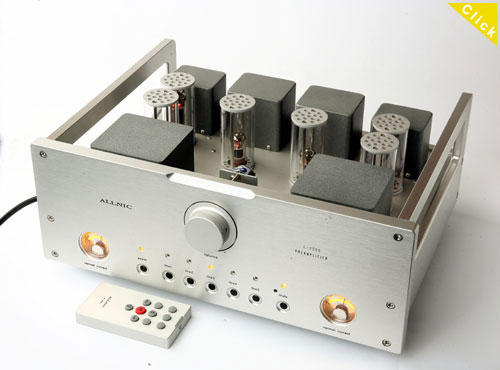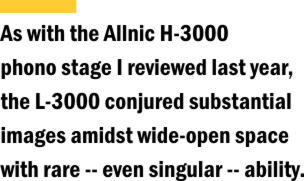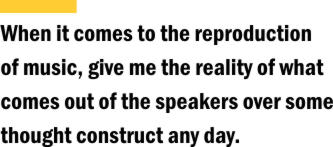Allnic Audio • L-3000 Preamplifier
riting about audio equipment isn't always what it's cracked up to be, but sometimes it is -- and more. Along with every review comes the grunt work of unpacking and packing products and the synesthesia required to translate sound into words. There are also the dozens, even hundreds, of hours of break-in for the product, as well as the listening and note-taking necessary to compile the observational information for the review. Amidst all that, there are rare instances when a product sounds right from the very beginning and only improves from there, making the time with it seem less like work and more like a story told through music. This was the case with the Allnic L-3000 line-stage preamp -- which was easy to unpack to boot.
The top-of-the-line L-3000 is yet another product from what seems like an endless source of audio-electronic designs: Kang Su Park, the CEO of Allnic Audio, located in South Korea. His role is far more hands on than his title would indicate. He designs every Allnic product, and he is closely involved with the company's manufacturing as well. Mr. Park goes the extra mile, as his electronics -- various preamps, amps and phono stages at different price levels -- use transformers that he also designs and manufactures. Because Allnic products are transformer coupled, as opposed to capacitor coupled, the in-house-manufactured transformers play a central role. Allnic transformers use Permalloy, an amalgam of iron and nickel developed almost a century ago. Its properties include high permeability and low coercivity, which make it a first-class material for use as a transformer core. Permalloy improves the sensitivity of the primary coils, which results in lower signal loss and wider bandwidth. The L-3000 is fully class A in operation, and it uses no negative feedback. It's an all-tube preamp, using pairs of E810Fs and 6485s in its line stage and two 7233s in its power supply, which is tube regulated. As with the tubes for the Allnic H-3000 phono stage I reviewed last year, none of the L-3000's tubes is common or easy to find. This is by necessity. The products' design requires that the tubes be "big generators," as Kang Su Park told me. "I need special tubes -- ones with high conductivity and low impedance," and the usual suspects just won't cut it. Two innovations the L-3000 employs are Allnic's patented Absorb GEL Tube Dampers and proprietary volume control. The Dampers, with their integral in-house-designed tube sockets, decouple the tubes from the chassis, isolating each tube from the others and the rest of the L-3000's circuitry, preventing the propagation of microphonics. The volume control was also a product of necessity, as Kang Su Park couldn't find one he liked, so he designed and made one himself. It uses silver contracts to ensure signal purity, and it's motorized, allowing for remote control of the L-3000. The motor, which makes a slight cogging noise when engaged, provides a reassuring bit of humanness to the L-3000. You can also adjust volume by hand via the large front-panel knob. The L-3000's styling is decidedly retro, right down to its half-dollar-sized illuminated meters that indicate the gain of the line-stage tubes. Allnic machines all of the chassis parts for its products, and the workmanship is exceptional, with tight fit and a satiny finish. I've seen units in both finishes, and I was sure the silver would look better until I saw the black. Three operational idiosyncrasies of the L-3000 are the power-cord inlet, the unit's phase switch and the Mute indicator. The power cord you use with the L-3000 may need to be a foot longer than normal because the IEC connector for it is on the side of the preamp. It's here because there's precious little room for it on the preamp's rear, and this placement provides greater isolation of the line stage and power supply. However, it raises the question of whether the L-3000 should simply have a separate power supply. The phase toggle switch is hidden behind the L-3000's front panel, and thus not accessible via the preamp's remote control. You may not notice that it's there, as happened to me. Regarding the Mute LED, it's counterintuitive -- indicating that the preamp is muted when it's not lit. In its stock form, the L-3000 provides 20dB of voltage gain, which is rather high. However, it's quiet enough to be used with high-gain amps, like my Lamm M1.2 monoblocks, which is not the case with other high-gain tube preamps I've used. If your speakers are highly sensitive, though, you still might hear an unacceptable amount of background hiss, in which case Allnic can add switchable gain to the L-3000, giving you the option of 20dB or 12dB. This will also ensure that your CD player won't blast you from the room with the preamp's volume at a tick above muted. Inquire about this at the time you order. "Right" defined ach audiophile is an island unto himself -- a bundle of unique beliefs and preferences that are responsible for the incredible diversity of audio equipment available today. Audio writers are no different, although we have to think differently if we're going to produce articles that are of value to a wide range of readers. Good audio writing is not created in an experiential vacuum. It is the product of understanding the subject, of course, but, moreover, of knowing yourself -- your beliefs and preferences, which can take hold of your thinking and skew your writing. If this happens and you're not mindful of it, your reviews become nothing more than dogmatic tomes -- and self-indulgent ones at that. Thus, when I wrote at the beginning of this review that the Allnic L-3000 sounded "right," I already had a firm grasp of what that meant -- for me and hopefully for you too. When I listen to any piece of audio gear, or any full system, there are two things that immediately define it: its tonality and spectral balance. Tonality determines the overall level of realism possible; when everything is "right," the instruments and voices display the earmarks of authenticity. This involves capturing the unique tonal personality of each instrument or singer as well as textural cues, like the rosiny drag of a bow against a violin string. Spectral balance refers to the overall symmetry of the product's sound from the highest treble to the lowest bass. Sound that leans toward either region -- or in favor of a narrow region in between -- ruins the balance that's important to reproducing music in a realistic, convincing way. Much of what made the Allnic L-3000 so immediately appealing was its tonality and spectral balance, which were spot on, revealing the interdependence of these two important traits. There was lavish tonal color -- not clumsy coloration but the tinting that, as with photography, gives what's captured the glory of the real thing. With this, the L-3000's top-to-bottom balance was acute, only a slight bit of midrange highlighting preventing perfection. This deviation was, in fact, welcome with the work of my latest musical obsession, Hank Williams. His voice -- plaintive and countrified -- is a unique instrument. He would have been considered a great talent if he had only been a singer, but, of course, his songs are among the best loved in the popular canon. His vocal gymnastics on "Ramblin' Man," which I played from the LP The Very Best of Hank Williams [MGM E-4168], were rife with warbling inflections and minute dynamic swings -- the things that mark the difference between good and great reproduction. His voice was also full and forcefully present, the bass and lap-steel accompaniment taking a secondary role.
When the recordings obliged, the results were supernatural in their palpability and front-to-back layering. I discovered Jakob Dylan's Seeing Things [Columbia 88697] via some musical networking. It's a recording of inherent warmth and rare spatial capacity -- and the bluesy music is very good too. There were times listening to "All Day and All Night" and "Evil is Alive and Well," two cuts I put on my CES demo CD-R, when the L-3000 created an unmatched ratio of air to corporeality, which resulted in the sort of involvement that urges us to tweak our gear in order to effect something akin to magic. But as other lesser recordings proved, the L-3000 was only bringing out what was there to begin with. Dry, flat recordings like Warren Zevon's Transverse City CD [Virgin 72435] were still dry and flat, but time and again recordings displayed spatial information that seemed new. Probably no recording venue is better known (to me at least) than Rudy Van Gelder's Englewood Cliffs, NJ, studio, and even the Blue Note RVG-series CDs, which are somewhat dry and flat themselves, were spatially vibrant over the L-3000 in ways they hadn't been before. Puzzling -- and exciting. While I wouldn't say the L-3000 represented the ultimate in bass power or dynamic bounce, its low-end weight and bloom gave recordings a sense of ambience that meshed expertly with its spatial abilities. I've noticed that certain subwoofers are able to broadcast low-frequency ambient information that imparts greater spaciousness and physical presence. The L-3000 does the same, while preserving the fine touch and texture of the upright bass on pianist Jeb Patton's New Strides CD [MaxJazz MXJ-221]. In terms of contemporary jazz labels, the grandchildren of Blue Note, MaxJazz stands out, offering tasteful, well-played, challenging jazz that always sounds warmly coherent. Patton displays intuitive feel for mid-tempo numbers that require both sensitive teamwork and perceptive soloing. The L-3000 was suave, even seductive, but not at the expense of the sonic truth. Again, recordings always retained their character, even as the L-3000 seemed to mine new veins of ambience and spatial information from them. As mentioned, the L-3000 highlighted the midrange a touch, which gave singers in particular a physicality and naturally rendered music a realistic kind of immediacy. This seemed more dimensional than tonal, however. By this I mean that vocals didn't sound any more chesty than they should, but singers again possessed a spooky palpability. There's a quality to Aimee Mann's voice that's largely obscured with overly midrangey products. It's best described as flintiness -- a girlish dryness that's the opposite of chestiness. "It's Not," the last tune on Lost in Space, is one of Mann's most compelling vocal performances, and that flintiness is central to her ability to express the pensive desire the dominates the song. "It's Not" on LP [Mobile Fidelity MFSL 1-278] simply reveals more musical information than either the CD or SACD. Is this a belief or preference? Both, really. It's a byproduct of experience that has transformed me as a listener. I was once (and for many years) digital only, but I now play more records than CDs and SACDs. The Allnic L-3000 magnified the difference, revealing the telling sonic qualities of digital and analog, and its personality always made listening an experience to be savored, especially if the recording possessed seemingly unknown levels of image solidity and soundstage dimension. No other preamp I've heard conveyed these things better. 3000 x 2 ike Kang Su Park, Kazutoshi Yamada is more than just the head of Zanden Audio, the Japanese maker of artisanal audio electronics. It's his designs on which the company was built. I've heard and written about a great deal of Mr. Yamada's equipment -- from his digital separates to his mono amplifiers. The last Zanden product I wrote about was the Model 3000 ($17,250), a two-box line-stage-only preamp that uses tubes in its line stage and separate power supply. While every other Zanden product I've heard had an obvious and endearing set of sonic qualities, the Model 3000 was "as neutral as Switzerland," to quote my review, a characterization that earned the Model 3000 a place on TAB's "The List," along with the other top-flight preamps we've heard and reviewed. Well, the L-3000 will also be making "The List," but for different reasons. Whereas the Model 3000 achieved utter neutrality, seeming to impart no trace of itself on the signal, the L-3000 placed musicians within a dimensional space that seemed completely realistic, even if it might represent some sort of enhancement to the recording. In terms of tonality, the Model 3000 accomplished the precision that the L-3000 just missed, while its spectral balance was just as skillfully handled, with the lowest bass lacking the level of ambient spread of the L-3000's. The muscular low frequencies of "3000 Miles" from Tracy Chapman's well-recorded Where You Live CD [Elektra 83803-2] were quick and throbbing with the Model 3000, more guttural and reverberant with the L-3000. Both preamps have nimble, lucid high frequencies, although the Model 3000 sounded slightly quicker into and out of each note. The L-3000's body through the midrange brought a level of solidity to voices that the Model 3000 couldn't equal, although it did differentiate massed strings, for instance, better than the L-3000. Don't ask me which is more neutral -- truly neutral, that is. It's an intellectual ideal, not something whose relevancy in terms of musical reproduction can be proved. Few people know what it sounded like in the studio the day the Beatles laid down "Come Together," for instance, and even if you were there, you'd have to concede that the cables and electronics and microphones added their own personalities to the outcome, making what was recorded for posterity on Abbey Road a facsimile of the live event.
All for one and one for Allnic he L-3000 is the second Allnic product I've reviewed, and it's the second Allnic product that's set a new personal standard in a couple of ways. There are many reasons to like the sound of the L-3000, including the fact that you'll never mistake it for sterile solid state, but it's the way it portrays the musicians in space -- what we're forever hoping to capture with our audio systems -- that makes it special. It's not just that it reveals presence and dimension, but also precise placement within the soundstage. This is unique and probably as close to being a replica of what's captured on the recording as possible. It also gets instrumental tone right, and its top-to-bottom balance is nearly flawless, a pleasing bit of midrange ripeness its only deviation. There are so many top-shelf preamps on the market that
choosing one to settle down with becomes as much an act of faith as love. While this
review literally began with a high point -- with the L-3000 sounding fully realized right
out of the box -- the rest of my time with the preamp was no less notable. Allnic's
distribution is improving by the day, but the company's products aren't easy to find.
Still, the L-3000 is one of the preamps to hear before you spend similar or more money on
something else.
|


 The L-3000 made these
artful songs, and the sublime grace of Hank Williams' singing, utterly compelling.
Williams died in 1953, so all of his recordings are in mono and they are fast approaching
70 years old, but the L-3000's spatial abilities -- the way it captured the venue and
provided presence through the midrange to transport the performance into the listening
room -- made for thrilling listening nonetheless. As with the Allnic H-3000 phono stage I
reviewed last year, the L-3000 conjured substantial images amidst wide-open space with
rare -- even singular -- ability.
The L-3000 made these
artful songs, and the sublime grace of Hank Williams' singing, utterly compelling.
Williams died in 1953, so all of his recordings are in mono and they are fast approaching
70 years old, but the L-3000's spatial abilities -- the way it captured the venue and
provided presence through the midrange to transport the performance into the listening
room -- made for thrilling listening nonetheless. As with the Allnic H-3000 phono stage I
reviewed last year, the L-3000 conjured substantial images amidst wide-open space with
rare -- even singular -- ability. And that's okay. When it
comes to the reproduction of music, give me the reality of what comes out of the speakers
over some thought construct any day. In this regard, neither of these preamps is lacking,
although the unrivaled presence of the Allnic L-3000 was difficult to ignore.
And that's okay. When it
comes to the reproduction of music, give me the reality of what comes out of the speakers
over some thought construct any day. In this regard, neither of these preamps is lacking,
although the unrivaled presence of the Allnic L-3000 was difficult to ignore.